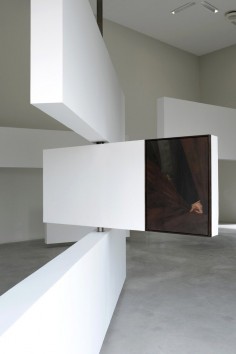Markus Schinwald

source: artspycn
作为一位多才多艺的艺术家,他在美术馆的每一间展厅里都呈现了其艺术创作的不同的一面。他对创作媒介的选择以他的想法、或是他希望自己的作品表现出来的强度为基础。有时候它们是绘画或雕塑,有时候则是影像或行为表演。带有五彩斑斓的鱼类的水下场景,机械呆板的木偶,让人联想到人体部位的家具,固定着油画作品的可移动的墙——马库斯·辛瓦尔德(Markus Schinwald)为这场展览打造了戏剧化的场景布置和可以活动的艺术作品。
作为观众,我们将会离开普通的世界,进入到马库斯·辛瓦尔德(Markus Schinwald)怪异而又美妙的世界中。这位艺术家创造出了一种令人困惑的氛围。他将第一个空间完全与外部世界隔离开来,遮挡了所有的日光。被包围在完全的黑暗中,他让观众的目光直接放到被照亮或是照亮了空间的展出作品上。贯穿展览的中心主题是“赋予生命”或者“被赋予生命”。作品可能通过技术性干预变得有了活力,成为了鱼类的装饰品或是暗示了一种特定的运动。他在这个完全黑暗的空间里安装了六个鱼缸,每一个鱼缸都按照展厅空间的方式进行布置,包括装饰性元素、艺术作品和在其周围游动的鱼儿。每一个水下世界都展示了不同种类的动物,从龙虾到上百只的霓虹灯鱼。观众的目光将在游动的鱼儿和静止的雕塑元素之间来回切换,与此同时,潺潺流水的声音也赋予了这件作品一种特别的音效。
另一个展厅里展出了马库斯·辛瓦尔德(Markus Schinwald)在近一年来新创作的油画作品。这位艺术家的绘画总是以他在跳蚤市场或者拍卖会上找到的画布为基础。在将它们修复之后,马库斯·辛瓦尔德(Markus Schinwald)会为其增添各种各样的元素。在这次展出的新作中,他没有使用自己早期绘画中的那种详尽深刻的形式,而是探索了一种新的方式——在其中,画作的主人公似乎消失在了巨大的画布里。在这个展厅里,你还会发现一些用桌腿制作而成的木质雕塑,它们会让你联想到人体的某些部分,而且扭曲得像是活动的舞蹈者,或是攀附在八米高的树枝上的被放大了的昆虫。展厅中竖着三面可活动的白墙,它们可以绕自己的轴线运动,每个墙体上还都装饰着油画,因而观众可以自由地操纵它们,形成不同的角度。
.
.
.
.
.
.
.
source: mu-inthecity
Pluridisciplinaire dans sa pratique, Markus Schinwald utilise tour à tour la peinture, la vidéo, la photographie, l’installation, la performance, le théâtre, la danse et même l’art du marionnettiste. De sa formation de designer de mode, l’artiste a conservé un intérêt certain pour le corps humain, s’intéressant à ses capacités et ses limitations, tant sur le plan physique que psychologique. Le corps comme représentation de l’individu, mais également comme construction culturelle, asservi tantôt par la norme, tantôt par des espaces imposés. Dans un processus de manipulation et d’altération des corps et de leur environnement, il nous offre une vision mouvante et fragmentée de son imaginaire. Subtilement mises en scène, ses œuvres disséminées dans un décor théâtral, à la manière d’un puzzle à reconstruire, suscitent tout à la fois un sentiment d’instabilité et de mystère. Le M Museum de Louvain accueille sa première rétrospective en Belgique.
.
.
.
.
.
.
.
source: mleuvenprezly
In Markus Schinwalds installaties, films, schilderijen, sculpturen en interactief werk onderzoekt hij de plaats van de mens in de wereld. Zijn leidraad hierbij is een bijzondere interesse in het menselijke lichaam en zijn zoektocht naar hoe we fysiek of mentaal beperkt worden door ons cultureel kader, onze gewoontes, onze emoties of de ruimte om ons heen. Verder heeft Schinwald een bijzondere aandacht voor de manier waarop mensen naar kunst kijken en hoe deze ervaring verschilt met andere manieren van kijken? Wat verwachten we? Wat kan ons boeien? Hoe verschilt het kijken naar stille objecten met het kijken naar bewegende lichamen of vissen in een aquarium?
Als bezoeker laat je de gewone wereld achter en treed je binnen in de bijzondere wereld van Markus Schinwald. De kunstenaar schept een bevreemdende sfeer. Hij sluit de eerste zalen volledig af van de buitenwereld en verbant alle daglicht. Verhuld in volledige duisternis trekt hij zo de blik van de bezoekers onmiddellijk naar de kunstwerken, die verlicht zijn of licht geven aan de ruimtes. De rode draad doorheen de tentoonstelling is ‘animeren’ of ‘geanimeerd worden’. Kunstwerken worden door technische ingrepen bezield, vormen het decor voor vissen of suggereren een beweging.
.
.
.
.
.
.
.
source: ropacnet
»The psychological analysis of space and body, the eeriness and discomfort, the deficient and the irrational depths of individual and collective existence are the themes Markus Schinwald (born 1973 in Salzburg) works on. The most diverse media-from disturbing films to puppet-like sculptures, from reworked historical paintings to prosthetic designs and clothes-playfully merge in his oeuvre and are subtly choreographed together.
Schinwald’s starting and observation point is the human body in its deficiency and eeriness. He no longer shows a firm, stable body, because its controlled shell-function has gone to pieces. Instead, he presents us with an osmotic body stage, a projection surface for the psychologically loaded inner worlds that permanently fight their way out and become manifest there. […]
In Foucault’s words, the body is the zero point at which all paths and spaces cross. The bodies in Schinwald’s works symptomatically react to their inner conditions and reflect outer experiences in their pose. The scenarios Schinwald develops do not follow a linear narration with a beginning and an end, but obsessively and repetitively circulate around a core content.
Thus, the films, pictures, and sculptures that at first appear to remain minimal and cool productions, condense into a complex effective structure that is open to a multitude of possibilities and stories which feed on our collective memory. They lead the viewer into a self-sustaining cosmos, an eerie and surreal system where normative boundaries are dissolved for the sake of the enigmatic and wonderful« (Heike Munder, 2008).
For the Annex of the gallery, Schinwald will develop an installation that refers precisely to the existing space. He will set up a system of corridors that starts at waist height, so the floor remains untouched, and a new ground plan begins at a height of roughly 1.20 m. Inside the narrow, stifling corridor system, Schinwald will arrange pictures and a puppet sculpture.
Recently, works by Markus Schinwald were shown at the exhibitions The World is a Stage at Tate Modern in London (2007), True Romance at Kunsthalle Wien (2007), 3. Berlin Biennale (2006), and others. The most extensive museum solo exhibition of this artist was presented this year at Migros Museum für Gegenwartskunst in Zurich. Kunsthaus Bregenz will dedicate a large solo exhibition to Schinwald in 2009.
Schinwald’s works are included in many public collections such as that of Musée d’Art Moderne Paris, Tate Modern London, Kunsthaus Zürich, Kunsthaus Bregenz, MUMOK Vienna, Migros Museum für Gegenwartskunst Zurich, the Belvedere museum in Vienna, MUSAC León, Neue Galerie Graz, Museum der Moderne Salzburg.

